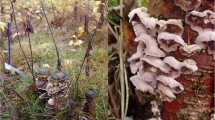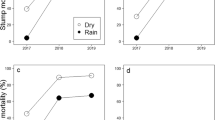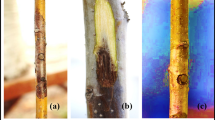Abstract
The efficacy of a decay fungus Chondrostereum purpureum (Pers. ex Fr.) Pouzar to prevent sprouting of two tree species, rowan (Sorbus aucuparia L.) and European aspen (Populus tremula L.) was investigated in a four-growing season study. The efficacy of C. purpureum compared with the control (cutting only) increased during the whole study period indicating that long-term studies are needed to reveal the real effect of the biocontrol treatment. At the end of the study period the mortality of treated rowan stumps was 50 % and that of European aspen 77 %, i.e. clearly higher than in the control with mortality 14 and 52 % respectively. The height of living sprouts was considerably lower in the C. purpureum treatment than in the control. Furthermore, our results indicated that a high number of surrounding conspecific saplings decreased whereas a high number of red raspberry (Rubus idaeus L.) shoots increased mortality of C. purpureum treated stumps.




Similar content being viewed by others
References
Beever DJ (1970) The relationship between nutrients in extracted xylem sap and the susceptibility of fruit trees to silverleaf disease caused by Stereum purpureum (Pers.) Fr. Ann Appl Biol 65:85–92
Bourdôt GW, Barton J, Hurrell GA, Gianotti AF, Saville DJ (2006) Chondrostereum purpureum and Fusarium tumidum independently reduce regrowth in gorse (Ulex europaeus). Biocontrol Sci Techn 16:307–327
Butler EJ, Jones SG (1949) Silver leaf of plum, Stereum purpureum (Fr.) Fr. In: plant pathology. MacMillian & Co, London, UK, pp 763–767
Coté J-F, Thibault J-R (1988) Allelopathic potential of raspberry foliar leachates on growth of ectomycorrhizal fungi associated with black spruce. Am J Bot 75:966–970
De Jong MD (2000) The BioChon story: deployment of Chondrostereum purpureum to suppress stump sprouting in hardwoods. Mycol 14:58–62
De Jong MD, Scheepens PC, Zadoks JC (1990) Risk analysis for biological control: a Dutch case study in biocontrol of Prunus serotina by the fungus Chondrostereum purpureum. Plant Dis 74:189–194
Etholén K (1974) The effect of felling time on the sprouting of Betula pubescens and Populus tremula in the seedling stands in Northern Finland. Folia For 213:1–16 (In Finnish with English summary)
Finnish Forest Research Institute (1995) National forest inventory data. Vantaa, Helsinki, Finland
Hamberg L, Malmivaara-Lämsä M, Löfström I, Vartiamäki H, Valkonen S, Hantula J (2011a) Sprouting of Populus tremula L. in spruce regeneration areas following alternative treatments. Eur J For Res 130:99–106
Hamberg L, Vartiamäki H, Malmivaara-Lämsä M, Löfström I, Valkonen S, Hantula J (2011b) Short-term effects of mechanical and biological treatments on Sorbus aucuparia L. sprouting in mesic forests in Finland. Scand J For Res 26:505–514
Harper GJ, Comeau PG, Hintz W, Wall RE, Prasad R, Becker EM (1999) Chondrostereum purpureum as a biological control agent in forest vegetation management. II. Efficacy on Sitka alder and aspen in western Canada. Can J For Res 29:852–858
Hester AJ, Millard P, Baillie GJ, Wendler R (2004) How does timing of browsing affect above- and below-ground growth of Betula pendula, Pinus sylvestris and Sorbus aucuparia? Oikos 105:536–550
Hughes JW, Fahey TJ (1991) Colonization dynamics of herbs and shrubs in a disturbed northern hardwood forest. J Ecol 79:605–616
Hyvämäki T (ed) (2002) Tapion taskukirja [The handbook of tapio]. Kustannusosakeyhtiö Metsälehti, Helsinki, Finland
Johansson T (1993) Seasonal changes in contents of root starch and soluble carbohydrates in 4–6-year old Betula pubescens and Populus tremula. Scand J For Res 8:94–106
Millard P, Hester A, Wendler R, Baillie G (2001) Interspecific defoliation responses of trees depend on sites of winter nitrogen storage. Funct Ecol 15:535–543
Mou P, Fahey TJ, Hughes JW (1993) Effects of soil disturbance on vegetation recovery and nutrient accumulation following whole-tree harvest of a northern hardwood ecosystem. J Appl Ecol 30:661–675
Oksanen J, Blanchet FG, Kindt R, Legendre P, O’Hara RB, Simpson GL, Solymos P, Stevens MHH, Wagner H (2011) vegan: Community Ecology Package. R package version 1.17-9. http://CRAN.R-project.org/package=vegan
Pitt DG, Dumas MT, Wall RE, Thompson DG, Lanteigne L, Hintz W, Sampson G, Wagner RG (1999) Chondrostereum purpureum as a biological control agent in forest vegetation management. I Efficacy on speckled alder, red maple, and aspen in eastern Canada. Can J For Res 29:841–851
R Core Team (2012) R: A language and environment for statistical computing. R Foundation for Statistical Computing, Vienna, Austria. ISBN 3-900051-07-0, URL http://www.R-project.org/
Ricard J-P, Messier C (1996) Abundance, growth and allometry of red raspberry (Rubus idaeus L.) along a natural light gradient in a northern hardwood forest. For Ecol Manage 81:153–160
Roy V, Dubeau D, Auger I (2010) Biological control of intolerant hardwood competition: silvicultural efficacy of Chondrostereum purpureum and worker productivity in conifer plantations. For Ecol Manage 259:1571–1579
Scheepens PC, Hoogerbrugge A (1989) Control of Prunus serotina in forests with the endemic fungus Chondrostereum purpureum. In: Delfosse ES (ed) Proceedings of the VII International Symposium on Biological Control of Weeds. Instituto Sperimentale de la Patologia Vegetale (MAF), Rome, Italy, pp 545–551
Suvanto LI, Latva-Karjanmaa TB (2005) Clone identification and clonal structure of the European aspen (Populus tremula). Mol Ecol 14:2851–2860
Valkonen S, Ruuska J, Siipilehto J (2002) Effect of retained trees on the development of young Scots pine stands in Southern Finland. For Ecol Manage 166:227–243
Vartiamäki H, Maijala P, Uotila A, Hantula J (2008a) Characterization of growth and enzyme production of Chondrostereum purpureum isolates and correlation of these characteristics with their capability to prevent sprouting of birch in field. Biol Control 47:46–54
Vartiamäki H, Uotila A, Vasaitis R, Hantula J (2008b) Genetic diversity in Nordic and baltic populations of Chondrostereum purpureum: a potential herbicide biocontrol agent. For Pathol 38:381–393
Vartiamäki H, Hantula J, Uotila A (2009) Effect of application time on the efficacy of Chondrostereum purpureum treatment against the sprouting of birch in Finland. Can J For Res 39:731–739
Venables WN, Ripley BD (2002) Modern applied statistics with s, 4th edn. Springer, New York, USA
Wall RE (1990) The fungus Chondrostereum purpureum as a silvicide to control stump sprouting in hardwoods. North J Appl Forestry 7:17–19
Whitney GG (1982) The productivity and carbohydrate economy of developing stand of Rubus idaeus. Can J Bot 60:2697–2703
Wilson AD, Shure DJ (1993) Plant competition and nutrient limitation during early succession in the Southern Appalachian Mountains. Am Midl Nat 129:1–9
Worrell R (1995) European aspen (Populus tremula L.): a review with particular reference to Scotland. I. Distribution, ecology and genetic variation. Forestry 68:93–105
Zerbe S (2001) On the ecology of Sorbus aucuparia (Rosaceace) with special regard to germination, establishment and growth. Pol Bot J 46:229–239
Acknowledgments
Private forest owners in the municipality of Sipoo provided their forests for the study and sites in Lapinjärvi were provided by the Finnish Forest Research Institute. We thank Sauli Valkonen for help to plan sampling design. Henna Vartiamäki, Asko Harju, Olavi Palosaari, Markku Rantala, Erkki Piiroinen, Juhani Mäkinen, Hannu Rantanen, Jere Eronen and Nea Kuusinen are acknowledged for their help in the field. Sari Elomaa modified the figures. The study was partly funded by Verdera Ltd., the Finnish Funding Agency for Technology and Innovation, Metsäteho Ltd., Fingrid Ltd., The Finnish Transport Agency and the Metsämiesten Säätiö Foundation.
Author information
Authors and Affiliations
Corresponding author
Additional information
Handling Editor: Monica Höfte.
Rights and permissions
About this article
Cite this article
Hamberg, L., Malmivaara-Lämsä, M., Löfström, I. et al. Effects of a biocontrol agent Chondrostereum purpureum on sprouting of Sorbus aucuparia and Populus tremula after four growing seasons. BioControl 59, 125–137 (2014). https://doi.org/10.1007/s10526-013-9550-y
Received:
Accepted:
Published:
Issue Date:
DOI: https://doi.org/10.1007/s10526-013-9550-y




